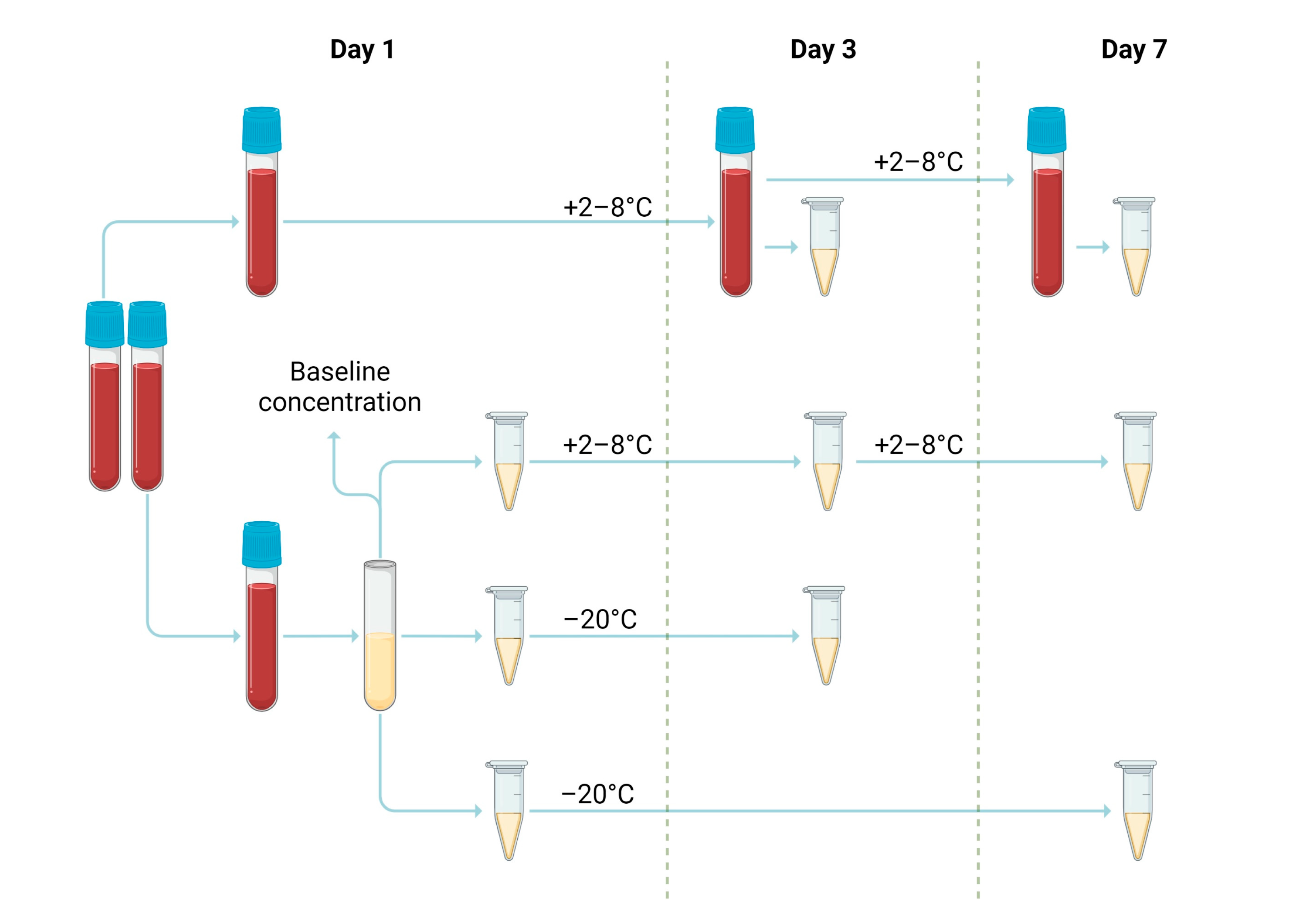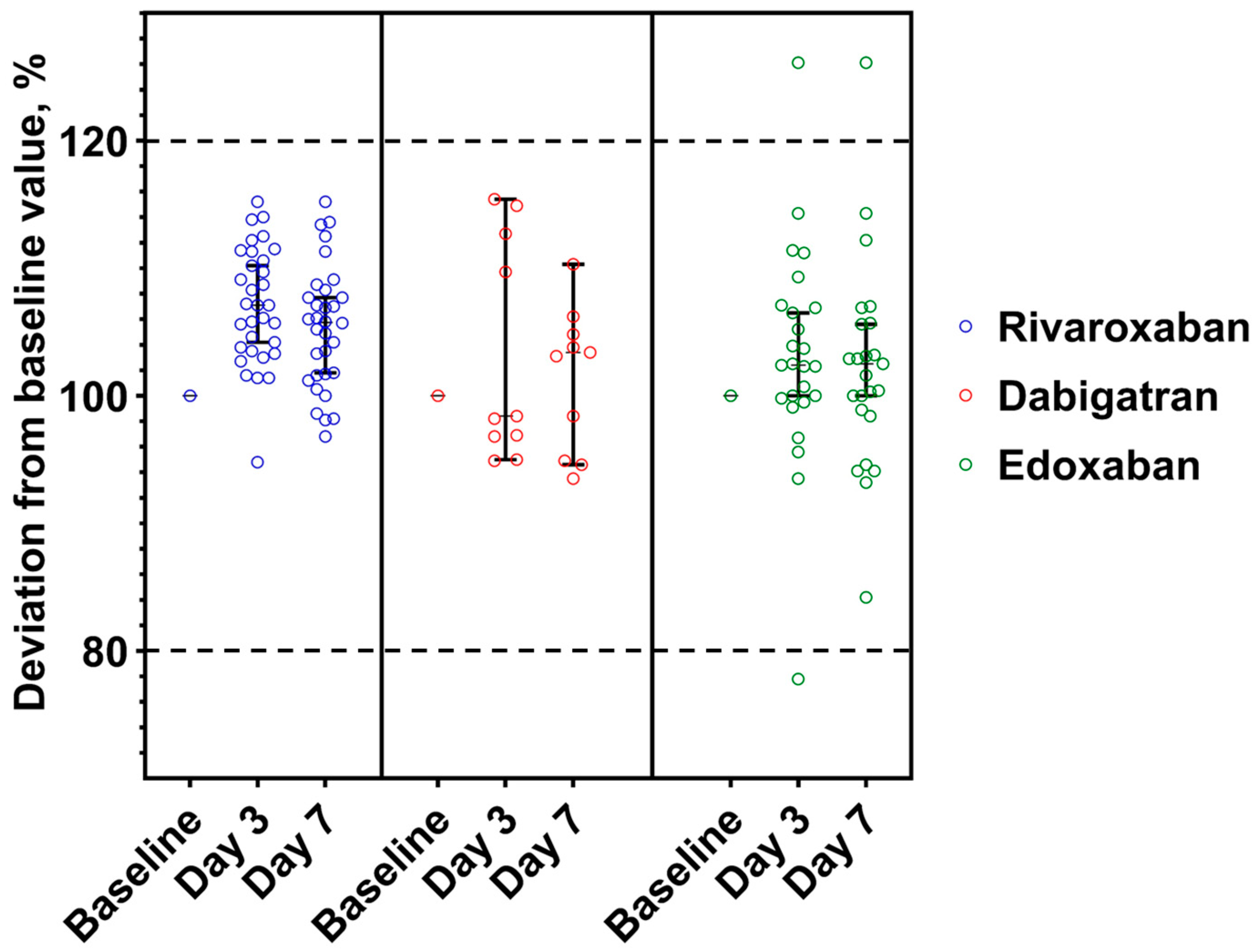Stability of Direct Oral Anticoagulants Concentrations in Blood Samples for Accessibility Expansion of Chromogenic Assays
Abstract
1. Introduction
2. Materials and Methods
2.1. Study Design
2.2. Sample Collection and Storage Conditions
2.3. Chromogenic Assays
2.3.1. Anti-Factor Xa (Fxa) Assay
2.3.2. Anti-Factor Iia (FIIa) Assay
2.4. Statistical Analysis
3. Results
3.1. Stability of DOACs in Whole Blood at +2–8 °C
3.2. Stability of DOACs in Plasma at +2–8 °C
3.3. Stability of DOACs in Frozen Plasma at −20 °C
4. Discussion
5. Conclusions
Author Contributions
Funding
Institutional Review Board Statement
Informed Consent Statement
Data Availability Statement
Acknowledgments
Conflicts of Interest
References
- Iyer, G.S.; Tesfaye, H.; Khan, N.F.; Zakoul, H.; Bykov, K. Trends in the Use of Oral Anticoagulants for Adults with Venous Thromboembolism in the US, 2010–2020. JAMA Netw. Open 2023, 6, e234059. [Google Scholar] [CrossRef] [PubMed]
- Sun, M.Y.; Bhaskar, S.M.M. Bridging the Gap in Cancer-Related Stroke Management: Update on Therapeutic and Preventive Approaches. Int. J. Mol. Sci. 2023, 24, 7981. [Google Scholar] [CrossRef] [PubMed]
- Kakkos, S.K.; Gohel, M.; Baekgaard, N.; Bauersachs, R.; Bellmunt-Montoya, S.; Black, S.A.; ten Cate-Hoek, A.J.; Elalamy, I.; Enzmann, F.K.; Geroulakos, G.; et al. Editor’s Choice—European Society for Vascular Surgery (ESVS) 2021 Clinical Practice Guidelines on the Management of Venous Thrombosis. Eur. J. Vasc. Endovasc. Surg. 2021, 61, 9–82. [Google Scholar] [CrossRef]
- Chen, A.; Stecker, E.; Warden, B.A. Direct oral anticoagulant use: A practical guide to common clinical challenges. J. Am. Heart Assoc. 2020, 9, 1–5. [Google Scholar] [CrossRef] [PubMed]
- Steffel, J.; Collins, R.; Antz, M.; Cornu, P.; Desteghe, L.; Haeusler, K.G.; Oldgren, J.; Reinecke, H.; Roldan-Schilling, V.; Rowell, N.; et al. 2021 European Heart Rhythm Association Practical Guide on the Use of Non-Vitamin K Antagonist Oral Anticoagulants in Patients with Atrial Fibrillation. Europace 2021, 23, 1612–1676. [Google Scholar] [CrossRef] [PubMed]
- Ruff, C.T.; Giugliano, R.P.; Braunwald, E.; Hoffman, E.B.; Deenadayalu, N.; Ezekowitz, M.D.; Camm, A.J.; Weitz, J.I.; Lewis, B.S.; Parkhomenko, A.; et al. Comparison of the efficacy and safety of new oral anticoagulants with warfarin in patients with atrial fibrillation: A meta-analysis of randomised trials. Lancet 2014, 383, 955–962. [Google Scholar] [CrossRef]
- Ferri, N.; Colombo, E.; Tenconi, M.; Baldessin, L.; Corsini, A. Drug-Drug Interactions of Direct Oral Anticoagulants (DOACs): From Pharmacological to Clinical Practice. Pharmaceutics 2022, 14, 1120. [Google Scholar] [CrossRef]
- Gelosa, P.; Castiglioni, L.; Tenconi, M.; Baldessin, L.; Racagni, G.; Corsini, A.; Bellosta, S. Pharmacokinetic drug interactions of the non-vitamin K antagonist oral anticoagulants (NOACs). Pharmacol. Res. 2018, 135, 60–79. [Google Scholar] [CrossRef]
- State Agency of Medicine Republic of Latvia. Statistics on Medicines Consumption 2018–2022. Available online: https://www.zva.gov.lv/lv/publikacijas-un-statistika/zalu-paterina-statistika-ddd (accessed on 15 May 2023).
- European Medicines Agency. Summary of Product Characteristics—Xarelto (rivaroxaban). Available online: https://www.ema.europa.eu/en/documents/product-information/xarelto-epar-product-information_en.pdf (accessed on 8 May 2023).
- European Medicines Agency. Summary of Product Characteristics—Pradaxa (dabigatran). Available online: https://www.ema.europa.eu/en/documents/product-information/lixiana-epar-product-information_en.pdf (accessed on 8 May 2023).
- European Medicines Agency. Summary of Product Characteristics—Lixiana (edoxaban). Available online: https://www.ema.europa.eu/en/documents/product-information/pradaxa-epar-product-information_en.pdf (accessed on 8 May 2023).
- European Medicines Agency. Summary of Product Characteristics—Eliquis (apixaban). Available online: https://www.ema.europa.eu/en/documents/product-information/eliquis-epar-product-information_en.pdf (accessed on 8 May 2023).
- Sennesael, A.L.; Larock, A.S.; Douxfils, J.; Elens, L.; Stillemans, G.; Wiesen, M.; Taubert, M.; Dogné, J.M.; Spinewine, A.; Mullier, F. Rivaroxaban plasma levels in patients admitted for bleeding events: Insights from a prospective study. Thromb. J. 2018, 16, 28. [Google Scholar] [CrossRef]
- Ferri, N. Pharmacokinetics and pharmacodynamics of DOAC. In Direct Oral Anticoagulants: From Pharmacology to Clinical Practice; Springer International Publishing: Berlin/Heidelberg, Germany, 2021; pp. 27–40. ISBN 9783030744625. [Google Scholar]
- Dunois, C. Laboratory monitoring of direct oral anticoagulants (DOACs). Biomedicines 2021, 9, 445. [Google Scholar] [CrossRef]
- Douxfils, J.; Mullier, F.; Robert, S.; Chatelain, C.; Chatelain, B.; Dogné, J.M. Impact of dabigatran on a large panel of routine or specific coagulation assays: Laboratory recommendations for monitoring of dabigatran etexilate. Thromb. Haemost. 2012, 107, 985–997. [Google Scholar] [CrossRef] [PubMed]
- Cuker, A.; Siegal, D.M.; Crowther, M.A.; Garcia, D.A. Laboratory measurement of the anticoagulant activity of the non-vitamin K oral anticoagulants. J. Am. Coll. Cardiol. 2014, 64, 1128–1139. [Google Scholar] [CrossRef] [PubMed]
- Gosselin, R.C.; Adcock, D.M.; Bates, S.M.; Douxfils, J.; Favaloro, E.J.; Gouin-Thibault, I.; Guillermo, C.; Kawai, Y.; Lindhoff-Last, E.; Kitchen, S. International Council for Standardization in Haematology (ICSH) Recommendations for Laboratory Measurement of Direct Oral Anticoagulants. Thromb. Haemost. 2018, 118, 437–450. [Google Scholar] [CrossRef] [PubMed]
- Kitchen, S.; Gray, E.; Mackie, I.; Baglin, T.; Makris, M. Measurement of non-Coumarin anticoagulants and their effects on tests of Haemostasis: Guidance from the British Committee for Standards in Haematology. Br. J. Haematol. 2014, 166, 830–841. [Google Scholar] [CrossRef]
- Siddiqui, F.; Hoppensteadt, D.; Jeske, W.; Iqbal, O.; Tafur, A.; Fareed, J. Factor Xa Inhibitory Profile of Apixaban, Betrixaban, Edoxaban, and Rivaroxaban Does Not Fully Reflect Their Biologic Spectrum. Clin. Appl. Thromb. 2019, 25, 1–11. [Google Scholar] [CrossRef]
- de Oliveira, A.C.; Davanço, M.G.; de Campos, D.R.; Sanches, P.H.G.; Cirino, J.P.G.; Carvalho, P.d.O.; Antônio, M.A.; Coelho, E.C.; Porcari, A.M. Sensitive LC–MS/MS method for quantification of rivaroxaban in plasma: Application to pharmacokinetic studies. Biomed. Chromatogr. 2021, 35, e5147. [Google Scholar] [CrossRef]
- Park, I.H.; Park, J.W.; Chung, H.; Kim, J.M.; Lee, S.; Kim, K.A.; Park, J.Y. Development and validation of LC–MS/MS method for simultaneous determination of dabigatran etexilate and its active metabolites in human plasma, and its application in a pharmacokinetic study. J. Pharm. Biomed. Anal. 2021, 203, 114220. [Google Scholar] [CrossRef]
- Ariizumi, S.; Naito, T.; Hoshikawa, K.; Akutsu, S.; Saotome, M.; Maekawa, Y.; Kawakami, J. Simple LC-MS/MS method using core-shell ODS microparticles for the simultaneous quantitation of edoxaban and its major metabolites in human plasma. J. Chromatogr. B Anal. Technol. Biomed. Life Sci. 2020, 1146, 122121. [Google Scholar] [CrossRef]
- Jeong, H.C.; Kim, T.E.; Shin, K.H. Quantification of apixaban in human plasma using ultra performance liquid chromatography coupled with tandem mass spectrometry. Transl. Clin. Pharmacol. 2019, 27, 33–41. [Google Scholar] [CrossRef]
- McRae, H.L.; Militello, L.; Refaai, M.A. Updates in anticoagulation therapy monitoring. Biomedicines 2021, 9, 262. [Google Scholar] [CrossRef]
- HYPHEN BioMed. BIOPHEN® DiXaI. Available online: https://www.hyphen-biomed.com/uploads/distributors/IFU/05-02_English/22xxxx/02_1030_DiXaI_v7-1.pdf (accessed on 5 September 2022).
- Siemens Healthcare Diagnostics. Instruction For Use — INNOVANCE® DTI; Siemens Healthcare Headquarters: Erlangen, Germany, 2017; pp. 1–7. [Google Scholar]
- Douxfils, J.; Mani, H.; Minet, V.; Devalet, B.; Chatelain, B.; Dogné, J.M.; Mullier, F. Non-VKA Oral Anticoagulants: Accurate Measurement of Plasma Drug Concentrations. Biomed Res. Int. 2015, 2015, 345138. [Google Scholar] [CrossRef] [PubMed]
- McGrail, R.; Revsholm, J.; Nissen, P.H.; Grove, E.L.; Hvas, A.M. Stability of direct oral anticoagulants in whole blood and plasma from patients in steady state treatment. Thromb. Res. 2016, 148, 107–110. [Google Scholar] [CrossRef]
- Thuile, K.; Giacomuzzi, K.; Jani, E.; Marschang, P.; Mueller, T. Evaluation of the in vitro stability of direct oral anticoagulants in blood samples under different storage conditions. Scand. J. Clin. Lab. Investig. 2021, 81, 461–468. [Google Scholar] [CrossRef] [PubMed]
- Schmitz, E.M.H.; Boonen, K.; van den Heuvel, D.J.A.; van Dongen, J.L.J.; Schellings, M.W.M.; Emmen, J.M.A.; van der Graaf, F.; Brunsveld, L.; van de Kerkhof, D. Determination of dabigatran, rivaroxaban and apixaban by ultra-performance liquid chromatography—Tandem mass spectrometry (UPLC-MS/MS) and coagulation assays for therapy monitoring of novel direct oral anticoagulants. J. Thromb. Haemost. 2014, 12, 1636–1646. [Google Scholar] [CrossRef] [PubMed]
- Reda, S.; Rudde, E.; Müller, J.; Hamedani, N.S.; Oldenburg, J.; Pötzsch, B.; Rühl, H. Variation in Plasma Levels of Apixaban and Rivaroxaban in Clinical Routine Treatment of Venous Thromboembolism. Life 2022, 12, 705. [Google Scholar] [CrossRef]




| DOAC | Sample (Temperature) | Median (Cl 95%), ng/mL (Median Deviation from Baseline Value, %) | ||||
|---|---|---|---|---|---|---|
| Baseline Value | Day 3 | p-Value * | Day 7 | p-Value * | ||
| Rivaroxaban | Whole blood (+2–8 °C) | 168 (147–236) | 187 (157–249) (7.1) | 0.865 | 182 (154–245) (5.7) | 0.963 |
| Plasma (+2–8 °C) | 173 (148–238) (0.7) | 0.997 | 171 (149–238) (0.2) | 0.993 | ||
| Plasma (−20 °C) | 168 (146–235) (0.0) | 0.977 | 173 (149–239) (1.8) | 0.972 | ||
| Dabigatran | Whole blood (+2–8 °C) | 139 (99–178) | 133 (103–185) (−1.6) | 0.985 | 130 (100–184) (3.4) | 0.882 |
| Plasma (+2–8 °C) | 137 (102–179) (1.5) | 0.874 | 134 (98–181) (1.3) | 0.865 | ||
| Plasma (−20 °C) | 126 (99–183) (−1.6) | 0.993 | 118 (95–176) (0.3) | 0.906 | ||
| Edoxaban | Whole blood (+2–8 °C) | 174 (135–259) | 178 (139–264) (2.4) | 0.949 | 179 (138–261) (2.5) | 0.990 |
| Plasma (+2–8 °C) | 169 (134–257) (−1.9) | 0.984 | 180 (125–255) (−3.7) | 0.962 | ||
| Plasma (−20 °C) | 167 (133–254) (−1.1) | 0.967 | 159 (130–251) (−1.9) | 0.869 | ||
| DOAC | Concentration, ng/mL (Deviation from Baseline, %) | ||
|---|---|---|---|
| Baseline Value | Day 3 | Day 7 | |
| Dabigatran | 24 | 33 (37.5) | 32 (33.3) |
| Edoxaban | 9 | 7 (−22.2) | 14 (55.6) |
| Edoxaban | 23 | 29 (26.1) | 29 (26.1) |
| DOAC | Concentration, ng/mL (Deviation from Baseline, %) | ||
|---|---|---|---|
| Baseline Value | Day 3 | Day 7 | |
| Rivaroxaban | 8 | 6 (−25.0) | 7 (−12.5) |
| Edoxaban | 9 | 14 (55.6) | 11 (22.2) |
| Edoxaban | 23 | 28 (21.7) | 27 (17.4) |
Disclaimer/Publisher’s Note: The statements, opinions and data contained in all publications are solely those of the individual author(s) and contributor(s) and not of MDPI and/or the editor(s). MDPI and/or the editor(s) disclaim responsibility for any injury to people or property resulting from any ideas, methods, instructions or products referred to in the content. |
© 2023 by the authors. Licensee MDPI, Basel, Switzerland. This article is an open access article distributed under the terms and conditions of the Creative Commons Attribution (CC BY) license (https://creativecommons.org/licenses/by/4.0/).
Share and Cite
Gavrilova, A.; Meisters, J.; Latkovskis, G.; Urtāne, I. Stability of Direct Oral Anticoagulants Concentrations in Blood Samples for Accessibility Expansion of Chromogenic Assays. Medicina 2023, 59, 1339. https://doi.org/10.3390/medicina59071339
Gavrilova A, Meisters J, Latkovskis G, Urtāne I. Stability of Direct Oral Anticoagulants Concentrations in Blood Samples for Accessibility Expansion of Chromogenic Assays. Medicina. 2023; 59(7):1339. https://doi.org/10.3390/medicina59071339
Chicago/Turabian StyleGavrilova, Anna, Jānis Meisters, Gustavs Latkovskis, and Inga Urtāne. 2023. "Stability of Direct Oral Anticoagulants Concentrations in Blood Samples for Accessibility Expansion of Chromogenic Assays" Medicina 59, no. 7: 1339. https://doi.org/10.3390/medicina59071339
APA StyleGavrilova, A., Meisters, J., Latkovskis, G., & Urtāne, I. (2023). Stability of Direct Oral Anticoagulants Concentrations in Blood Samples for Accessibility Expansion of Chromogenic Assays. Medicina, 59(7), 1339. https://doi.org/10.3390/medicina59071339






